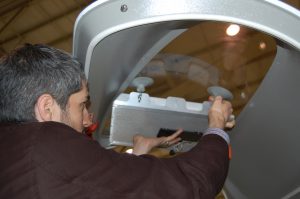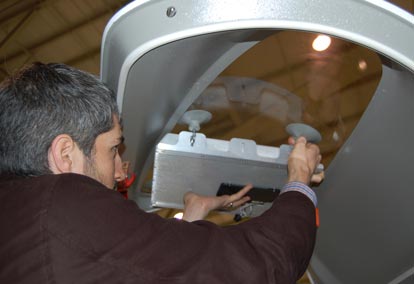
A software-defined, electronically-reconfigurable antenna technology developed by researchers at the Georgia Institute of Technology has now been tested on land, in the air and on the ocean.
U.S. Department of Defense representatives attended an event earlier this year in which the capabilities of Georgia Tech’s Agile Aperture Antenna (A3), which can change beam directions in less than a second, were demonstrated in an aircraft during flight tests held in Virginia. The event, held in February 2014, marks the university’s latest effort to evaluate the abilities of their technology, having already tested it on a moving ground vehicle and on a Wave Glider autonomous ocean vehicle.
During the flight tests, “one device, looking up, maintained a satellite data connection as the aircraft changed headings, banked and rolled, while the other antenna looked down to track electromagnetic emitters on the ground,” a university press release stated. The upward-looking antenna had a beam 30 degrees wide that could be shifted up to 60 degrees in either direction in order to maintain contact with the satellite, while the downward-looking antenna’s beam was adjusted to “stare” at a fixed point on the ground to reduce interference from nearby emitters. An inertial measurement unit provided information about the aircraft’s pitch, roll, yaw, longitude, latitude and altitude to a controller in charge of elements that change the beam’s direction to maintain communication. The location of the commercial satellite with which the device was communicating with was programmed in before takeoff.
“We were able to sustain communication with the commercial satellite in flight as the aircraft changed headings dramatically,” Matthew Habib, a GTRI research engineer, said. “The antenna was changing beam directions to compensate for the aircraft headings. At the same time, we were maintaining communication with a device on the ground.”
The flat, low-power A3 is seen as an ideal device for use in UAVs, which have small power supplies and limited surface area for antenna integration, because of its ability to alter beam direction as fast as 120 degrees in one-thousandth of a second. The antenna’s frequency and polarization can also be changed by switching active components.
“If you have a large ship or aircraft with lots of power, you can afford to use a phased-array or other type of steerable antenna,” Habib said. “But when you are using small vehicles, especially robotic aircraft and self-sustaining vehicles that don’t include an operator, our antenna is a great solution.”
The antenna concept could also be used in mobile devices, where its dynamic tenability could help cut through congestion on cellular networks, says GTRI research engineer Ryan Westafer.
“A small electronically tunable antenna could provide a lot of new opportunities for mobile devices,” he said.
According to the researchers, the A3 flight test prototype operates from 500 to 3,000 MHz with a plus or minus 60-degree hemispherical view. Other prototypes have been able to provide gain to 6 GHz. Comprised of printed circuit boards, the antenna components weigh only two or three pounds and has thus far operated successfully at temperatures between -10 degrees below zero Fahrenheit and 100 degrees Fahrenheit.
The researchers hope the antenna system will one day become standard in all ground, air and sea vehicles.
“This is changing the way that we think about integrating antennas onto systems to provide new solutions,” Habib said. “Users have not had these capabilities before, and we are excited to see how our partners will be able to take full advantage of this antenna.”
GTRI collaborated with SR Technologies, Inc. a Florida company specializing in wireless engineering products, for the flight test. GTRI also collaborated with Aurora Flight Sciences to fly the antennas on their Centaur optionally-piloted aircraft.
